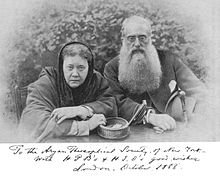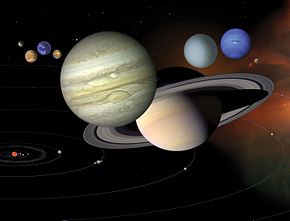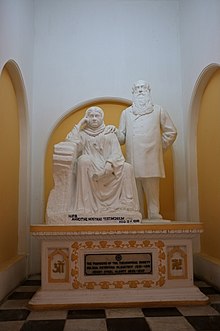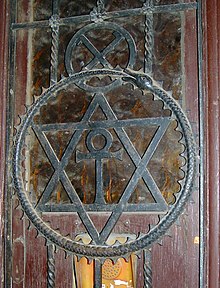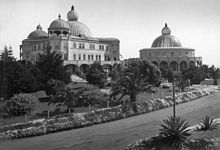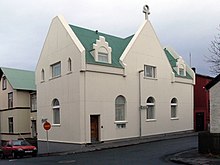From Wikipedia, the free encyclopedia
The logo for the Theosophical Society brought together various ancient symbols
As taught by Blavatsky, Theosophy teaches that there is an ancient and secretive brotherhood of spiritual adepts known as
Mahatmas, who—although found across the world—are centered in
Tibet.
These Masters are believed to have cultivated great wisdom and
seemingly-supernatural powers, and Theosophists believe that it was they
who initiated the modern Theosophical movement through disseminating
their teachings via Blavatsky. They believe that these Masters are
attempting to revive knowledge of an ancient religion once found across
the world and which will again come to eclipse the existing
world religions.
Theosophical groups nevertheless do not refer to their system as a
"religion". Theosophy preaches the existence of a single, divine
Absolute. It promotes an
emanationist
cosmology in which the universe is perceived as outward reflections
from this Absolute. Theosophy teaches that the purpose of human life is
spiritual emancipation and claims that the human soul undergoes
reincarnation upon bodily death according to a process of
karma. It promotes values of universal brotherhood and social improvement, although it does not stipulate particular ethical codes.
Theosophy was established in
New York City in 1875 with the founding of the
Theosophical Society by Blavatsky,
Henry Olcott, and
William Quan Judge. Blavatsky and Olcott relocated to India, where they established the Society's headquarters at
Adyar,
Tamil Nadu. Blavatsky described her ideas in two books,
Isis Unveiled and
The Secret Doctrine. Blavatsky was repeatedly accused of fraudulently producing purportedly supernatural phenomena, often in connection with these "masters". Following Blavatsky's death in 1891, there was a schism in the Society, with Judge leading the
Theosophical Society in America to secede. Under Judge's successor
Katherine Tingley, a Theosophical community named
Lomaland was established in
San Diego. The Adyar-based Society was later taken over by
Annie Besant, under whom it grew to its largest extent during the late 1920s, before going into decline.
Theosophy played a significant role in bringing knowledge of
South Asian religions to Western countries, as well as in encouraging
cultural pride in various South Asian nations. A variety of prominent
artists and writers have also been influenced by Theosophical teachings.
Theosophy has an international following, and during the twentieth
century had tens of thousands of adherents.
Theosophical ideas have also exerted an influence on a wide range of
other esoteric movements and philosophies, among them
Anthroposophy, the
Church Universal and Triumphant, and the
New Age.
Definition
Theosophy's founder, the Russian
Helena Blavatsky, insisted that it was not a religion,
although did refer to it as the modern transmission of the "once
universal religion" that she claimed had existed deep into the human
past. That Theosophy should not be labelled a religion is a claim that has been maintained by Theosophical organisations,
who instead regard it as a system that embraces what they see as the
"essential truth" underlying religion, philosophy, and science. As a result, Theosophical groups allow their members to hold other religious allegiances, resulting in Theosophists who also identify as Christians, Buddhists, or Hindus.
Some scholars of religion who have studied Theosophy have characterised it as a religion.
In his history of the Theosophical movement, Bruce F. Campbell noted
that Theosophy promoted "a religious world-view" using "explicitly
religious terms" and that its central tenets are not unequivocal fact,
but rather rely on belief.
Olav Hammer and Mikael Rothstein termed it "one of the modern world's most important religious traditions". Various scholars have pointed to its eclectic nature;
Joscelyn Godwin described it as a "universally eclectic religious movement",
while scholar J. Jeffrey Franklin characterised Theosophy as a "hybrid
religion" for its syncretic combination of elements from various other
sources.
Scholars have also classified Theosophy as a form of
Western esotericism. Campbell for instance referred to it as "an esoteric religious tradition", while the historian Joy Dixon called it an "esoteric religion". More specifically, it is considered a form of occultism. Along with other groups like the
Hermetic Order of the Golden Dawn,
the Theosophical Society has been seen as part of an "occult revival"
that took place in Western countries during the late nineteenth century. The historian of religion
Wouter Hanegraaff noted that Theosophy helped to establish the "essential foundations for much of twentieth-century esotericism".
Although Theosophy draws upon Indian religious beliefs, the sociologist of religion
Christopher Partridge
observed that "Theosophy is fundamentally Western. That is to say,
Theosophy is not Eastern thought in the West, but Western thought with
an Eastern flavour."
Etymology
Blavatsky and Olcott, two of the founding members of the Theosophical Society
At a meeting of the Miracle Club in
New York City on 7 September 1875, Blavatsky, Olcott, and Judge agreed to establish an organisation, with
Charles Sotheran suggesting that they call it the
Theosophical Society.
Prior to adopting the name "Theosophical", they had debated various
potential names, among them the Egyptological Society, the Hermetic
Society, and the Rosicrucian Society. The term was not new, but had been previously used in various contexts by the
Philaletheians and the
Christian mystic Jakob Böhme.
Etymologically, the term came from the Greek
theos ("god(s)") and
sophia ("wisdom"), thus meaning "god-wisdom", "divine wisdom", or "wisdom of God". The term
theosophia appeared (in both Greek and Latin) in the works of early
church fathers, as a synonym for
theology. In her book
The Key to Theosophy, Blavatsky claimed that the term "Theosophy" had been coined by "the Alexandrian philosophers", especially
Ammonius Saccas.
That Blavatsky's Theosophy is not the only movement to use the
term "theosophy" has resulted in scholarly attempts to differentiate the
different currents.
Godwin drew a division by referring to Blavatskian Theosophy with a
capital letter and older, Boehmian theosophy with a lower-case letter. Alternately, the scholar of esotericism
Wouter J. Hanegraaff distinguished the Blavatskian movement from its older namesake by terming it "modern Theosophy".
Followers of Blavatsky's movement are known as Theosophists, while adherents of the older tradition are termed theosophers. Causing some confusion, a few Theosophists — such as C. C. Massey — were also theosophers.
In the early years of Blavatsky's movement, some critics referred to it
as "Neo-Theosophy" to differentiate it from the older Christian
theosophy movement. The term "
Neo-Theosophy"
would later be adopted within the modern Theosophical movement itself,
where it was used—largely pejoratively—to describe the teachings
promoted by
Annie Besant and
Charles Webster Leadbeater by those who opposed their innovations.
According to the scholar of religion James A. Santucci,
discerning what the term "Theosophy" meant to the early Theosophists is
"not as obvious as one might think".
As used by Olcott, the term "Theosophy" appeared to be applied to an
approach that emphasised experimentation as a means of learning about
the "Unseen Universe"; conversely, Blavatsky used the term in reference
to gnosis regarding said information.
Beliefs and teachings
Although
the writings of prominent Theosophists lay out a set of teachings, the
Theosophical Society itself states that it has no official beliefs with
which all members must agree. It therefore has doctrine but does not
present this as dogma.
The Society stated that the only tenet to which all members should
subscribe was a commitment "to form a nucleus of the Universal
Brotherhood of Humanity without distinction of race, creed, sex, caste
or color".
This means that there were members of the Theosophical Society who were
sceptical about many, or even all, of the Theosophical doctrines, while
remaining sympathetic to its basic aim of universal brotherhood.
As noted by Santucci, Theosophy is "derived primarily from the writings" of Blavatsky, however revisions and innovations have also been produced by subsequent Theosophists like Annie Besant and Charles Leadbeater.
Blavatsky claimed that these Theosophical doctrines were not her own
invention, but had been received from a brotherhood of secretive
spiritual adepts whom she referred to as the "Masters" or "Mahatmas".
The Masters
Hermann
Schmiechen's 1884 depiction of the two Masters whom Blavatsky claimed
to be in contact with, Koot Humi (left) and Morya (right).
Central to Theosophical belief is the idea that a group of spiritual
adepts known as the Masters not only exist but were responsible for the
production of early Theosophical texts. For most Theosophists, these Masters are deemed to be the real founders of the modern Theosophical movement.
In Theosophical literature, these Masters are also referred to as the
Mahatmas, Adepts, Masters of Wisdom, Masters of Compassion, and Elder
Brothers.
They are perceived to be a fraternity of human men who are highly
evolved, both in terms of having an advanced moral development and
intellectual attainment. They are claimed to have achieved extra-long life spans, and to have gained supernatural powers, including
clairvoyance and the ability to instantly project their soul out of their body to any other location. These are powers that they have allegedly attained through many years of training. According to Blavatsky, by the late 19th century their chief residence was in the Himalayan kingdom of
Tibet. She also claimed that these Masters were the source of many of her published writings.
The Masters are believed to preserve the world's ancient spiritual knowledge, and to represent a Great White Brotherhood or White Lodge which watches over humanity and guides its evolution.
Among those whom the early Theosophists claimed as Masters were Biblical figures like
Abraham,
Moses,
Solomon, and
Jesus, Asian religious figures like
Gautama Buddha,
Confucius, and
Laozi, and modern individuals like
Jakob Bohme,
Alessandro Cagliostro, and
Franz Mesmer. However, the most prominent Masters to appear in Theosophical literature are
Koot Hoomi (sometimes spelled Kuthumi) and Morya, with whom Blavatsky claimed to be in contact. According to Theosophical belief, the Masters approach those deemed worthy to embark on an apprenticeship or
chelaship.
The apprentice would then undergo several years of probation, during
which they must live a life of physical purity, remaining chaste,
abstinent, and indifferent to physical luxury. Blavatsky encouraged the production of images of the Masters. The most important portraits of the Masters to be produced were created in 1884 by
Hermann Schmiechen. According to scholar of religion
Massimo Introvigne, Schmiechen's images of Morya and Koot Humi gained "semi-canonical status" in the Theosophical community, being regarded as sacred objects rather than simply decorative images.
Campbell noted that for non-Theosophists, the claims regarding
the existence of the Masters are among the weakest made by the movement.
Such claims are open to examination and potential refutation, with
challenges to the existence of the Masters therefore undermining
Theosophical beliefs.
The idea of a brotherhood of secret adepts had a long pedigree
stretching back several centuries before the foundation of Theosophy;
such ideas can be found in the work of the
Rosicrucians, and was popularised in the fictional literature of
Edward Bulwer-Lytton.
The idea of having messages conveyed to a medium through by spiritually
advanced entities had also been popularised at the time of Theosophy's
foundation through the Spiritualist movement.
The ancient wisdom religion
According
to Blavatsky's teachings, many of the world's religions have their
origins in a universal ancient religion, a "secret doctrine" that was
known to
Plato and early Hindu sages and which continues to underpin the centre of every religion.
She promoted the idea that ancient societies exhibited a unity of
science and religion that humanity has since lost, with their
achievements and knowledge being far in excess of what modern scholars
believe about them.
Blavatsky also taught that a secret brotherhood has conserved this
ancient wisdom religion throughout the centuries, and that members of
this fraternity hold the key to understanding miracles, the afterlife,
and psychic phenomena, and that moreover these adepts themselves have
paranormal powers.
She stated that this ancient religion would be revived and spread
throughout humanity in the future, replacing dominant world religions
like
Christianity,
Islam,
Buddhism, and
Hinduism.
Theosophy tended to emphasise the importance of ancient texts over the
popular ritual and custom found within various religious traditions.
The Theosophical depiction of Buddhism and Hinduism however drew
criticism both from practitioners of orthodox Buddhist and Hindu
traditions, as well as from Western scholars of these traditions, such
as
Max Müller, who believed that Theosophists like Blavatsky were misrepresenting the Asian traditions.
Theology and cosmology
Theosophy promotes an
emanationist cosmology, promoting the belief that the universe is an outward reflection from the Absolute.
Theosophy presents the idea that the world as humans perceive it is illusory, or
maya, an idea that it draws from Asian religions. Accordingly, Blavatsky taught that a life limited by the perception of this illusory world was ignorant and deluded.
According
to Theosophical teaching, each solar system is an emanation of a
"Logos" or "Solar Deity", with planetary spirits each overseeing one of
the planets.
According to Blavatsky's teaching, every
solar system in the universe is the expression of what is termed a "Logos" or "Solar Deity".
Ranked below this Solar Deity are seven ministers or planetary spirits,
with each of these celestial beings being in control of evolution on a
particular planet.
In
The Secret Doctrine, Blavatsky stated that each planet had a
sevenfold constitution, known as the "Planetary Chains"; these consist
not only of a physical globe but also of two astral bodies, two mental
bodies, and two spiritual bodies, all overlapping in the same space.
According to Blavatsky, evolution occurs on descending and ascending
arcs, from the first spiritual globe on to the first mental globe, then
from the first astral globe to the first physical globe, and then on
from there.
She claimed that there were different levels of evolution, from mineral
on to vegetable, animal, human, and then to superhuman or spiritual.
Different levels of evolution occur in a successive order on each
planet; thus when mineral evolution ends on the first planet and it
proceeds on to vegetable evolution, then mineral evolution begins on the
second planet.
Theosophy teaches that human evolution is tied in with this planetary and wider cosmic evolution.
In
The Secret Doctrine, Blavatsky advocated the idea of seven "
Root Races", each of which was divided into seven Sub-Races.
In Blavatsky's cosmogony, the first Root Race were created from pure
spirit, and lived on a continent known as the "Imperishable Sacred
Land". The second Root Race, known as the Hyperboreans, were also formed from pure spirit, and lived on a land near to the
North Pole, which then had a mild climate. The third lived on the continent of
Lemuria, which Blavatsky alleged survives today as Australia and Rapa Nui.
Blavatsky alleged that during the fourth Round of the Earth, higher
beings descended to the planet, with the beginnings of human physical
bodies developing, and the sexes separating. At this point, the fourth Root Race appeared, living on the continent of
Atlantis; they had physical bodies but also psychic powers and advanced technology. She claimed that some Atlanteans were giants, and built such ancient monuments as
Stonehenge in southern England, and that they also mated with "she-animals", resulting in the creation of
gorillas and
chimpanzees.
The Atlanteans were decadent and abused their power and knowledge, so
Atlantis sunk into the sea, although various Atlanteans escaped, and
created new societies in Egypt and the Americas.
The fifth Root Race to emerge was the Aryans, and was found across the world at the time she was writing. She believed that the fifth Race would come to be replaced by the sixth, which would be heralded by the arrival of
Maitreya, a figure from Mahayana Buddhist mythology. She further believed that humanity would eventually develop into the final, seventh Root Race. At this, she stated that humanity will have reached the end of its evolutionary cycle and life will withdraw from the Earth.
Lachman suggested that by reading Blavatsky's cosmogonical claims as a
literal account of history, "we may be doing it a disservice."
He instead suggested that it could be read as Blavatsky's attempt to
formulate "a new myth for the modern age, or as a huge, fantastic
science fiction story".
Maitreya and messianism
Blavatsky taught that Lord Maitreya—a figure she borrowed from Buddhist mythology—would come to Earth as a messianic figure. Her ideas on this were expanded upon by Besant and Leadbeater. They claimed that Maitreya had previously incarnated onto the Earth as
Krishna, a figure from Hindu mythology. They also claimed that he had entered
Jesus of Nazareth at the time of
the latter's baptism, and that henceforth Maitreya would be known as "the Christ". Besant and Leadbeater claimed that Maitreya would again come to Earth by manifesting through an Indian boy named
Jiddu Krishnamurti, whom Leadbeater had encountered playing on a beach at Adyar in 1909. The introduction of the Krishmanurti belief into Theosophy has been identified as a
millenarian element.
Personal development and reincarnation
Statue of Blavatsky and Olcott at Adyar
According to Theosophy, the purpose of human life is the spiritual emancipation of the soul.
The human individual is described as an "Ego" or "Monad" and believed
to have emanated from the Solar Deity, to whom it will also eventually
return. The human being is presented as composing of seven parts, while operating on three separate planes of being. As presented by Sinnett and often repeated in Theosophical literature, these seven parts are the Body (Rupa), Vitality (Prana-Jiva), the Astral Body (Linga Sarira), the Animal Soul (Kama-Rupa), the Human Soul (Manas), the Spiritual Soul (Buddhi), and the Spirit (Atma).
According to Theosophical teaching, it is the latter three of these
components that are immortal, while the other aspects perish following
bodily death.
Theosophy teaches that the Spiritual Soul and the Spirit do not reside
within the human body alongside the other components, but that they are
connected to it through the Human Soul.
In The Voice of the Silence, Blavatsky taught that within
each individual human there is an eternal, divine facet, which she
referred to as "the Master", the "uncreate", the "inner God", and the
"higher self". She promoted the idea that uniting with this "higher
self" results in wisdom.
In that same book, she compared the progress of the human soul to a
transition through three halls; the first was that of ignorance, which
is the state of the soul before it understands the need to unite with
its higher self. The second is the Hall of Learning, in which the
individual becomes aware of other facets of human life but is distracted
by an interest in psychic powers. The third is the Hall of Wisdom, in
which union with the higher self is made; this is then followed by the
Vale of Bliss. At this point the human soul can merge into the One.
Reincarnation and karma
Throughout
her writings, Blavatsky made a variety of statements about rebirth and
the afterlife, and there is a discrepancy between her earlier and later
teachings on the subject. Between the 1870s and circa 1882, Blavatsky taught a doctrine called "metempsychosis".
In
Isis Unveiled, Blavatsky stated that on bodily death, the human soul progresses through more spiritual planes. Two years later, she introduced the idea of
reincarnation into Theosophical doctrine, using it to replace her metempsychosis doctrine. In
The Secret Doctrine, she stated that the spirit was immortal and would repeatedly incarnate into a new, mortal soul and body on Earth.
According to Theosophical teaching, human spirits will always be reborn
into human bodies, and not into those of any other life forms.
Blavatsky stated that spirits would not be reborn until some time after
bodily death, and never during the lifetime of the deceased's
relatives.
Blavatsky taught that on the death of the body, the astral body survives for a time in a state called
kama-loka, which she compared to
limbo, before also dying. According to this belief, the human then moves into its mental body in a realm called
devachan, which she compared to
Heaven or
paradise. Blavatsky taught that the soul remained in devachan for 1000 to 1500 years, although the Theosophist
Charles Webster Leadbeater claimed that it was only 200.
Theosophy espouses the existence of
karma
as a system which regulates the cycle of reincarnation, ensuring that
an individual's actions in one life affect the circumstances of their
next one.
This belief therefore seeks to explain why misery and suffering exist
in the world, attributing any misfortune that someone suffers as
punishment for misdeeds that they perpetrated in a prior life. In Blavatsky's words, karma and reincarnation were "inextricably interwoven".
However, she did not believe that karma had always been the system that
governed reincarnation; she believed that it came into being when
humans developed egos, and that one day will also no longer be required.
Besant and Leadbeater claimed to be able to investigate people's past lives through reading the
akashic record, an etheric store of all the knowledge of the universe.
They for instance claimed to have attained knowledge of their own past
lives as monkey-like creatures residing on the moon, where they served
as pets to the "Moon-man" (a prior incarnation of the Master Morya), his
wife (Koot Humi), and their child (the Lord Maitreya). When they were
attacked by "savages" and animals "resembling furry lizards and
crocodiles", Besant sacrificed herself to save Morya, and for that act
made the karmic evolutionary leap to becoming a human in her next
incarnation.
Morality and ethics
The Theosophical seal as door decoration in Budapest, Hungary
Theosophy does not express any formal ethical teaching, a situation that generated ambiguity. However, it has expressed and promoted certain values, such as brotherhood and social improvement.
During its early years, the Theosophical Society promoted a puritanical attitude toward sexuality, for instance by encouraging
chastity even within marriage.
By 1911, the Theosophical Society was involved in projects connected to a range of
progressive political causes. In England, there were strong links between Theosophy and
first-wave feminism.
Based on a statistical analysis, Dixon noted that prominent English
feminists of the period were several hundred times more likely to join
the Theosophical Society than were the average member of the country's
population.
Theosophical contingents took part in feminist marches of the period;
for instance, a Theosophical group operating under the banner of
Universal Co-Freemasonry marched as part of the
Women's Coronation Procession in 1911.
Ritual
The Theosophical Society did not prescribe any specific
rituals for adherents to practice. However, ritualised practices have been established by various Theosophical groups; one such group is the
Liberal Catholic Church.
Another are the meetings of the United Lodge of Theosophy, which have
been characterised as having a "quasi-sacred and quasi-liturgical"
character.
Historical development
The American social
situation from which the Theosophical Society emerged was one of great
upheaval, and the religious situation was one of challenge to orthodox
Christianity. The forces that had surfaced in spiritualism included
anticlericalism, anti-institutionalism, eclecticism, social liberalism,
and belief in progress and individual effort. Occultism, mediated to
America in the form of Mesmerism, Swedenborgianism, Freemasonry, and
Rosicrucianism, was present. Recent developments in science led by the
1870s to renewed interest in reconciling science and religion. There was
present also a hope that Asian religious ideas could be integrated into
a grand religious synthesis.
— Bruce F. Campbell, 1980.
The Theosophical Society was largely the creation of two individuals: Helena Blavatsky and Henry Steel Olcott.
Established Christianity in the United States was experiencing
challenges in the second half of the nineteenth century, a result of
rapid urbanization and industrialization, high rates of immigration, and
the growing understanding of
evolutionary theory which challenged traditional Christian accounts of history. Various new religious communities were established in different parts of the country, among them the
Free Religious Association,
New Thought,
Christian Science, and
Spiritualism. Theosophy would inherit the idea — then popular in the United States — that emphasized the idea of
free will and the inevitability of
progress, including on a spiritual level. It was also influenced by a growing knowledge about Asian religions in the United States.
Prior to her arrival in the United States, Blavatsky had experience with esoteric currents like Spiritualism.
It was through Spiritualism that Blavatsky and Olcott met.
In 1884, Olcott established the first Scottish lodge, in Edinburgh.
In 1980, Campbell noted that Theosophical books were selling at record levels.
In the United States, Judge had been devoting himself to the promotion of Theosophy with little success.
Post-Blavatsky
During her lifetime, Blavatsky had suggested to many different persons that they would be her successor. Three of the most prominent candidates — Olcott, Judge, and Besant — all met in London shortly after to discuss the situation.
Judge claimed that he too was in contact with the Masters, and that
they had provided him with a message instructing him to co-delegate the
Society's Esoteric Section with Besant.
Olcott however suspected that the notes from the Masters which Judge
was producing were forged, exacerbating tensions between them.
Besant attempted to act as a bridge between the two men, while Judge
informed her that the Masters had revealed to him a plot that Olcott was
orchestrating to kill her.
In 1893, Besant came down on Olcott's side in the argument and backed
the internal proceedings that Olcott raised against Judge.
A two-stage enquiry took place, which concluded that because the
Society took no official stance on whether the Masters existed or not,
Judge could not be considered guilty of forgery and would be allowed to
retain his position. The details of this trial were leaked to the journalist
F. Edmund Garrett, who used them as the basis of his critical book,
Isis Very Much Unveiled.
Judge then announced that the Masters had informed him that he should
take sole control of the Esoteric Section, deposing Besant; she rejected
his claims.
Amid calls from Olcott that Judge should stand down, in April 1895 the
American section voted to secede from the main Society. Judge remained
its leader, but died within a year.
Besant with the child Krishnamurti
Olcott then sent Besant to the United States to gain support for the
Adyar-based Society. In this she was successful, gaining thousands of
new members and establishing many new branches.
Besant had developed a friendship with the Theosophist
Charles Webster Leadbeater, and together they co-wrote a number of books. Leadbeater was controversial, and concerns were raised when he was found to have instructed two boys in
masturbation. The American Section of the Theosophical Society raised internal charges against him, although Besant came to his defence.
In a move probably designed to limit negative publicity for the
Society, they accepted his resignation rather than expelling him.
On Olcott's death in 1907, he had nominated Besant to be his
successor, and she was then elected to the position with a large
majority in June.
In her first years as the head of the Society, Besant oversaw a
dramatic growth in its membership, raising it by 50%, to 23,000. She also oversaw an expansion of the Adyar property, from 27 to 253 acres. Besant was involved in various activist causes, promoting women's rights in India through the
Women's Indian Association and helping to establish both the
Central Hindu College and a Hindu girls' school. Besant also began a campaign for Indian Home Rule, founding a group called the Home Rule League. She established the
New India newspaper, and after continuing to promote Indian independence in the paper's pages during the
First World War she was interned for several months. This helped to boost her status within the independence movement, and at the age of 70 she was appointed President of the
Indian National Congress, a largely honorary position.
In December 1908, Leadbeater was readmitted to the Society; this generated a wave of resignations, with the
Sydney branch seceding to form the Independent Theosophical Society. Leadbeater travelled to Adyar, where he met a young boy living there,
Jiddu Krishnamurti, and pronounced him to be the next incarnation of a figure called the
World Teacher. He subsequently took control of the boy's instruction for two years. With Besant, Leadbeater established a group known as the
Order of the Star in the East to promote the idea of Krishnamurti as World Teacher.
Leadbeater also wanted more ritual within Theosophy, and to achieve this he and
J. I. Wedgwood became bishops in the
Old Catholic Church. They then split from that to form their own
Liberal Catholic Church, which was independent from the Theosophical Society (Adyar) while retaining an affiliation with it. The Church drew most of its membership from the Society and heavily relied upon its resources.
However, in 1919 the Church was marred by police investigations into
allegations that six of its priests had engaged in acts of
paedophilia and Wedgewood — who was implicated in the allegations — resigned from the organisation.
The Raja Yoga Academy and the Temple of Peace, c. 1915
In retaliation, a "Back to Blavatsky" movement emerged within the
Society. Its members pejoratively referred to Besant and her followers
as practitioners of "Neo-Theosophy", objecting to the Liberal Catholic
Church's allegiance to the Pope, and to the prominence that they were
according to Besant and Leadbeater's publications. The main benefactor of the disquiet within the Back to Blavatsky movement was a rival group called the
United Lodge of Theosophists. One of the most prominent figures to switch allegiance was
B. P. Wadia.
The United Lodge of Theosophists had been established in
Los Angeles in 1909, when it had split from Judge's Theosophical Society in America, seeking to minimise formal organisation.
It focused on publishing new editions of Blavatsky and Judge's
writings, as well as other books, which were usually released
anonymously so as to prevent any personality cults developing within the
Theosophical movement.
The Adyar Society membership later peaked at 40,000 in the late 1920s.
The Order of the Star had 30,000 members at its height.
Krishnamurti himself repudiated these claims, insisting that he was not
the World Teacher, and then resigned from the Society; the effect on the
society was dramatic, as it lost a third of its membership over the
coming few years. Besant died in 1933, when the Society was taken over by
George Arundale, who led it until 1945; the group's activities were greatly curtailed by
World War II.
Judge left no clear successor as leader of the Theosophical Society in America, but the position was taken by
Katherine Tingley, who claimed that she remained in mediumistic contact with Judge's spirit.
Kingley launched an international campaign to promote her Theosophical
group, sending delegations to Europe, Egypt, and India. In the latter
country they clashed with the Adyar-based Theosophical Society, and were
unsuccessful in gaining converts. Her leadership would be challenged by Ernest T. Hargrove in 1898, and when he failed he split to form
his own rival group. In 1897, Tingley had established a Theosophical community,
Lomaland, at
Point Loma in
San Diego, California. Various Theosophical writers and artists congregated there, while horticultural development was also emphasised.
In 1919, the community helped establish a Theosophical University.
Longstanding financial problems coupled with an ageing population resulted in the Society selling Lomaland in 1942. Meanwhile, Tingley's death in 1929 had resulted in the Theosophical Society in America being taken over by
Gottfried de Purucker, who promoted rapprochement with other Theosophical groups in what came to be known as the Fraternisation movement.
Demographics
Theosophical Society lodge building in Reykjavík, Iceland
During its first century, Theosophy established itself as an international movement.
Campbell believed that from its foundation until 1980, Theosophy had gained tens of thousands of adherents.
He noted that in that latter year, there were circa 35,000 members of
the Adyar-based Theosophical Society (9000 of whom were in India),
c.5,500 members of the Theosophical Society in America, c.1500 members
of the Theosophical Society International (Pasadena), and about 1200
members of the United Lodge of Theosophy. Membership of the Theosophical Society reached its highest peak in 1928, when it had 45,000 members.
Theosophical groups consist largely of individuals as opposed to family groups. Campbell noted that these members were alienated in ways from conventional social roles and practices.
As noted by Dixon, in the late nineteenth and early twentieth
centuries, the Theosophical Society "appealed above all to an elite,
educated, middle- and upper-middle-class constituency". It was, in her words, "a religion for the 'thinking classes'." Campbell stated that Theosophy attracted "unconventional, liberal-minded Westerners",
and according to Dixon they were among those "who constituted
themselves as the humanitarian conscience of the middle classes, a
dissident minority who worked in a variety of parallel organizations to
critique the dominant bourgeois values and culture."
Campbell also noted that Theosophy appealed to educated Asians,
and particularly Indians, because it identified Asia as being central to
a universal ancient religion and allowed Asians to retain traditional
religious beliefs and practices within a modern framework.
Reception and legacy
Hammer
and Rothstein believed that the formation and early history of the
Theosophical Society was one of the "pivotal chapters of religious
history in the West." The Theosophical Society had significant effects on religion, politics, culture, and society.
In the Western world, it was a major force for the introduction of Asian religious ideas.
In 1980, Campbell described it as "probably the most important non-traditional or occult group in the last century", while in 2012 Santucci noted that it had had "a profound impact on the contemporary religious landscape".
A Theosophical bookshop in Buenos Aires, Argentina
In approaching Asian religion with respect and treating its religious
beliefs seriously, Blavatsky and Olcott influenced South Asian society. In India, it played an important role in the Indian independence movement and in the Buddhist revival. The Indian independence leader
Mahatma Gandhi developed much of his interest in Hindu culture after being given a copy of the
Bhagavad Gita by two Theosophists. Alongside her support for Indian home rule, Besant had also supported home rule for Scotland, Wales, and Ireland. Campbell suggested that Theosophy could be seen as a "grandfather" movement to this 20th century growth in Asian spirituality.
Given the spread of such ideas in the West, some critics have perceived Theosophy's role as being largely obsolete.
Influence on the arts and culture
Many
important figures, in particular within the humanities and the arts,
were involved in the Theosophical movement and influenced by its
teachings. Prominent scientists who had belonged to the Theosophical Society included the inventor
Thomas Edison, the biologist
Alfred Russel Wallace, and the chemist
William Crookes.
Theosophy also exerted an influence on the arts.
Theosophy was also an influence over a number of early pioneers of
abstract art. The Russian
abstract expressionist Wassily Kandinsky was very interested in Theosophy and Theosophical ideas about colour. The Dutch abstract artist
Piet Mondrian was also influenced by Theosophical symbolism.
Theosophical ideas were also an influence on the Irish literary
movement of the late 19th and early 20th century, with writers like
Charles Johnston,
George Russell,
John Eglinton,
Charles Weeks, and
William Butler Yeats having an interest in the movement.
The American adventure fiction writer
Talbot Mundy included Theosophical themes in many of his works. He had abandoned his previous allegiance to
Christian Science to join the Theosophical faction led by Tingley, joining the Society in 1923 and settling at the Point Loma community.
Influence on other religious and esoteric groups
Bestsellers and
television shows are devoted to Theosophical concepts such as
reincarnation and spiritual evolution; the Internet overflows with
references to Theosophical concepts such as the human aura (a Google
search in May 2012 retrieved 47 million hits) and the chakras (12
million hits). Even truly mainstream media such as the National
Geographic Channel present programs devoted to arch-Theosophical themes
such as Atlantis, and the spiritual mysteries of Egypt. Terms and ideas
created or mediated by spokespersons of the Theosophical Society have
over time become household words, and the advent of Theosophy thus
marked a fundamental change in the religious lives of countless
individuals. — Olav Hammer and Mikael Rothstein, 2013.
The founders of many later new religious movements had been involved in Theosophy.
Many esoteric groups — such as Alice Bailey's
Arcane School and
Rudolf Steiner's
Anthroposophy — are "directly dependent" on Theosophy.
Although he had split from Theosophy when renouncing Leadbeater's claim
that he was the World Teacher, Krishnamurti continued to exhibit
Theosophical influences in his later teachings. In 1923 a former Theosophist, the Anglo-American
Alice Bailey, established the
Arcane School, which also rested on claims regarding contact with the Ascended Masters.
Another former Theosophist, the Austrian Rudolf Steiner, split
from the Theosophical Society over the claims about Krishnamurti and
then established his own
Anthroposophical Society in 1913, which promoted
Anthroposophy, a philosophy influenced by Theosophical ideas.
Despite his departure from the Theosophists, Rudolf Steiner
nevertheless maintained a keen interest in Theosophy for the rest of his
life.
As Theosophy entered the
Völkisch movement of late 19th century Austria and Germany, it syncretised to form an eclectic occult movement known as
Ariosophy. The most prominent Ariosophist, the Austrian
Guido von List, was influenced by Theosophical ideas in creating his own occult system.
In the United States during the 1930s, the
I AM group was established by
Guy Ballard and Edna Ballard; the group adopted the idea of the Ascended Masters from Theosophy.
The idea of the Masters—and a belief in Morya and Kuthumi—have also been adopted into the belief system of the
Church Universal and Triumphant. The Canadian mystic
Manly P. Hall also cited Blavatsky's writings as a key influence on his ideas. Theosophical ideas, including on the evolution of the Earth, influenced the teachings of British conspiracist
David Icke.
Hammer and Rothstein stated that Theosophy came to heavily
influence "popular religiosity" and by the late twentieth and
twenty-first centuries was "permeating just about every nook and cranny
of contemporary "folk" religious culture" in Western countries. It was a major influence on the
New Age milieu of the latter twentieth century. It played an important role in promoting belief in reincarnation among Westerners.
Scholarly research
Theosophy Hall in Manhattan, New York City
A considerable amount of literature has been produced on the subject of Theosophy and the Theosophical Society. Most early publications on Theosophy fell into two camps: either
apologetic and highly defensive, or highly antagonistic and aggressive towards the movement. As of 2001, the scholar of religion
Olav Hammer could still note that books presenting the Theosophical doctrines were mostly apologetic in nature. Examples of such works include William Q. Judge's 1893 book
Ocean of Theosophy and
Robert Ellwood's 1986 book
Theosophy.
He noted that most of these works treated Theosophical doctrine as if
it were a fixed entity and provided little or no discussion of how they
have changed over the decades. Many articles on the historical development of the movement have also appeared in the journal
Theosophical History.
Many early scholars of religion dismissed Theosophy as being not worthy of study;
Mircea Eliade for instance described Theosophy as a "detestable 'spiritual' hybridism".
The academic study of the Theosophical current developed at the
intersection of two scholarly sub-fields: the study of new religious
movements, which emerged in the 1970s, and the study of Western
esotericism.
A significant proportion of the scholarship on Theosophy constitutes
biographies of its leading members and discussions of events in the
Society's history.
In contrast to the significant amount of research focused on the first
two generations of Theosophists, little has been produced on later
figures.
Hammer also lamented that while scholarship on Theosophy was
developing, it had not focused on the reformulation of Theosophy by
Leadbeater and Besant or with the developing ideas of post-Theosophical
writers like Steiner or Bailey.
Hammer and Rothstein suggested that the "dearth of scholarly
literature" on Theosophy was because "powerful individuals and
institutions" in Europe and North America regarded the religion as
"ludicrous", thus discouraging scholars from devoting their time to
researching it.

